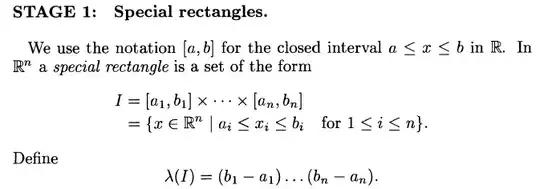Question:
Prove that every nonempty open subset $G$ of $\mathbb{R}^n$ can be expressed as a countable union of nonoverlapping closed rectangles, $G= \bigcup_{k=1}^\infty I_k$.
Attempt: My idea is to tile $\mathbb{R}^n$ with cubes of side 1. Then discard the cubes that do not intersect with $G$. Then repeat. However, I'm not sure if this is the right approach, since it may only approximate $G$. I also would be unsure of how to formalize such an approach. Alternative ideas would be appreciated.
Here's some additional context since there's quite a bit of discussion on the problem. The problem as originally written in Chapter 2 of Lebesgue Integration on Euclidean Space by Frank Jones reads:

Of course, we need to know what a special rectangle is. This is defined as follows (essentially just a closed rectangle):
